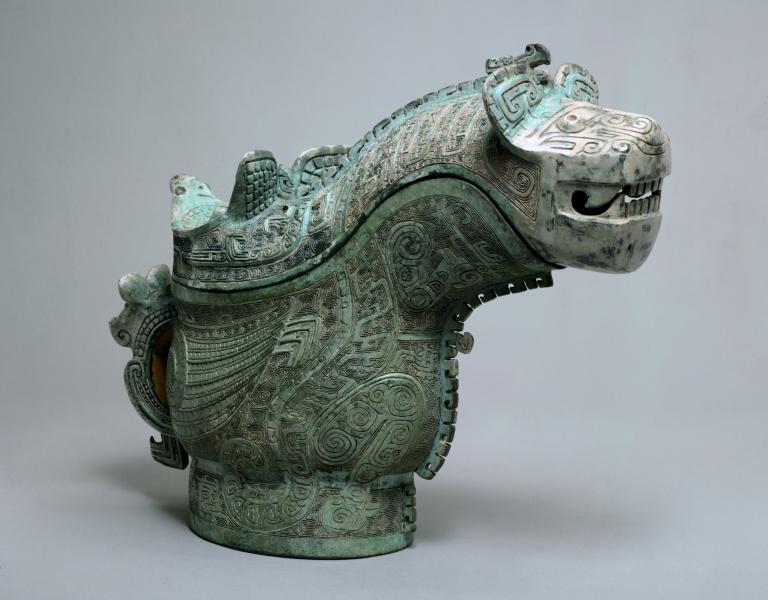Bronze Vessels
15 min readIn the late Neolithic Age, Chinese ancient culture entered the period of simultaneous use of bronze and stones, and provided various preconditions for bronze vessels’ development. A bronze knife 5,000 years old cast with a single mold and unearthed from the Linjia site in Dongxiang County, Gansu (belonging to the Majiayao Culture) is the earliest bronze vessel ever discovered The bronze “Houmuwu”Rectangle Ding of the Shang Dynasty, kept in the National Museum of China.
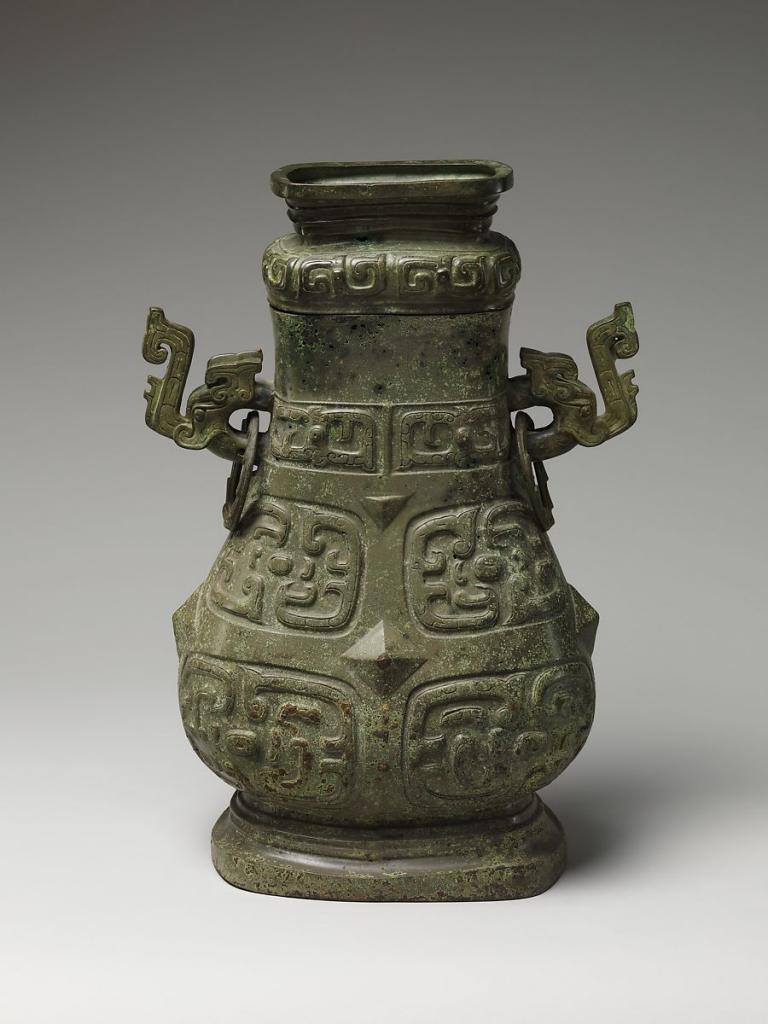
Apart from preparation of casting techniques, bronze vessels’ artistic factor can be traced to stone ware, pottery ware and jade ware in the late Neolithic Age. For example, the shapes of tools and weapons among bronze vessels mostly originated from stone ware, and the shapes of containers among bronze vessels mostly originated from pottery ware. Bronze tripod caldrons, tripods, bronze wine holders, etc. all have pottery prototypes. Patterns on bronze vessels are also like that. For example, the origin of the most famous pattern on bronze vessels-the taotie pattern -can be found in the jade ware of the Longshan Culture in the Neolithic Age. The Erlitou Culture between the Longshan Culture and the Shang Culture already belongs to the Bronze Age. Among the bronze vessels from the Erlitou site in Yanshi, Henan, there are not only tools, weapons and ornaments, but also containers made according to standards and conspicuous turquoise inlays. Natural copper is red, so it is called red copper.
Bronze is greyish blue alloy of red copper and chemical elements such as tin and lead. The record about “regular molds, high-quality copper and tin, skillful smelting workers and proper heating durations and ingredients”in Xunzi-National Borders describes the processes of manufacturing bronze vessels, including mineral refinement, mold production, casting and modification. Manufacturing of bronze vessels developed from cold forging to casting and from production of simple tools with single molds to production of combined molds. This was a great leap in process. Molds were made using the combined mold method (mainly pottery molds) and the lost wax method: the former means shaping inner and outer molds with mud according to utensils’ shapes, the distance between the outer mold and the inner mold being the thickness of utensils’walls; the latter means making utensils’ models with wax spraying mud repeatedly until thick enough, drying the mud, heating it to let the smelt wax flow out, and then pour smelt copper in. The lost wax method was created in the Spring and Autumn Period and the Warring States Period and used to cast complex and delicate bronze vessels.
It is still used today. “The six ingredients of bronze” mentioned in The Records of Examination of Craftsman refers to the standard proportions of the six ingredients of bronze vessels. This is the first clear record about proportions of alloy constituents used in casting bronze vessels in the world. Bronze vessels have the advantages low melting points and high degrees of hardness. Utensils for different uses have different ingredient proportions. For example, “the proportion between copper and tin in bells and tripod cauldrons is 6: 1; the proportion between copper and tin in axes is 5:1.”Therefore, bells and tripod cauldrons have magnificent luster, while axes have the attribute of hardness. Chinese bronze vessels peaked for the first time in the late Shang Dynasty and the early Western Zhou Dynasty. The production center was the Shang capital Yin located in today’s Anyang, Henan. In the early Shang Dynasty, there were abundant types of bronze vessels, and bases were thin; in the late period, there were numerous types of bronze vessels, bases were thick and heavy, and sizes were huge.
The “Houmuwu” large square tripod cauldron(previously called Simuwu tripod cauldron) is the largest bronze vessel ever discovered. Because the tripod cauldron is large and heavy, the bottom-up casting method must be adopted. The hollow ears of the tripod cauldron were connected to the body. The casting of this large tripod cauldron required at least 100 to 200 artisans’ close coordination and simultaneous operation. Besides, 200 to 300 people needed to be gathered for transportation and coal burning. This shows the large scale and high level of bronze vessel production. Line drawing of bronze wine vessels of the Shang and Zhou dynasties In the Shang Dynasty, the main type of bronze vessels was sacrificial vessels, and other common ones included musical instruments, tools and carriage parts. Because the Shang Dynasty’s ruling class liked excessive drinking, drinking vessels were most developed among sacrificial vessels, e.g. bronze wine holders, three-legged wine cups, goblets, drinking vessels and wine vessels made of horn were drinking vessels; wine vessels, wooden drinking vessels, vases, pots, bronze drinking vessels and ancient wine vessels were wine containers; round-mouthe- and three-legged- wine cups, bronze wine holders and three-legged wine cups were wine-warming utensils. Some utensils had multiple functions, e.g. bronze wine holders and three-legged wine cups could be used to drink wine and warm wine, and the three legs at the bottom should be intended to facilitate heating. Drinking vessels’shapes are associated with their functions.
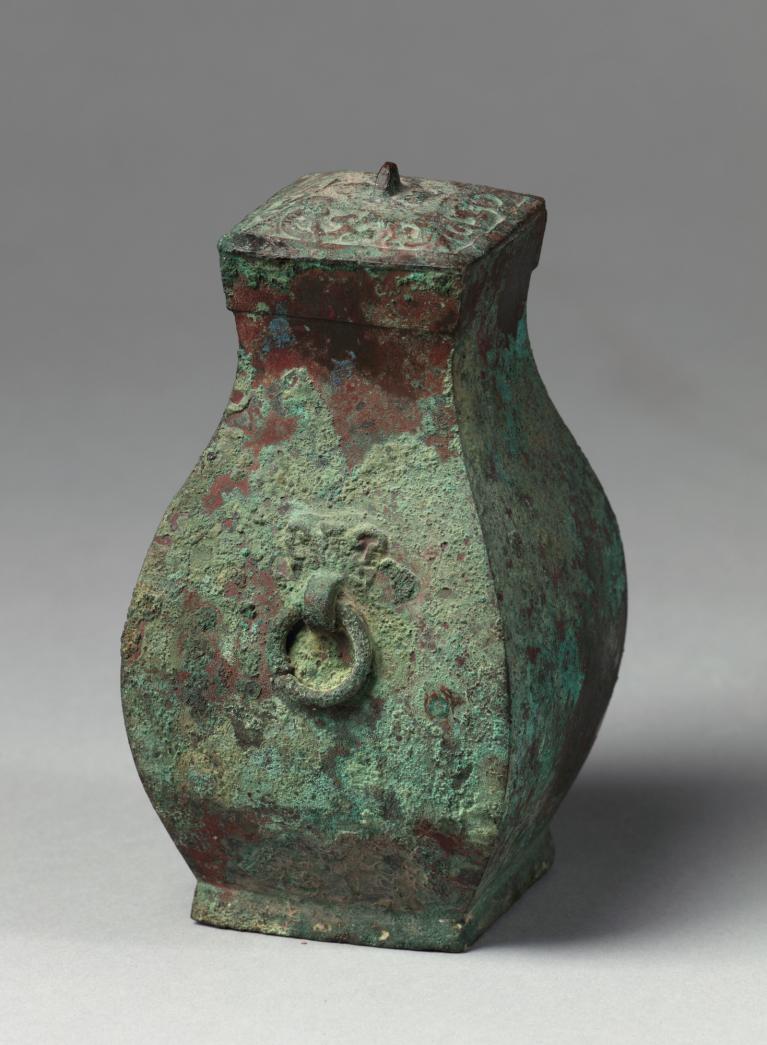
Because drinking vessels needed to be held by hand, they were usually light and small; wine containers were usually large and often had lids for keeping wine clean. Some utensils fall into multiple categories, e.g. three-legged pots could be used to store both wine and water; animal-shaped drinking vessels could also be used as ornaments. Apart from drinking vessels, sacrificial vessels also included eating utensils and water containers. Eating utensils included cooking utensils (such as tripod cauldrons for boiling meat, tripods for boiling porridge and cooking utensils similar to steamers) and food containers (such as round-mouthed food vessels with two or four loop handles, square grain receptacles and bronze vessels); water containers were mainly gourd-shaped ladles and dishes. Among them, tripod cauldrons symbolizing power had strong political and religious color. Rubbing of beast-face veins of the bronze ware of the Shang and Zhou dynasties Sanlian Yan in Fuhao Tomb in the later period of the Shang Dynasty, with a similar function to today’s steamer. Line drawing of bronze tableware of the Shang and Zhou Dynasties Decorations on bronze vessels were simple in the mid-Shang Dynasty, and refined and complicated in the late period. Multilayered patterns of complicated, magnificent and mysterious styles emerged. Dense patterns on bronze vessels were pursued in the Shang Dynasty. Cloud and thunder patterns were often used as backgrounds to highlight three-dimensional effect. The main patterns were prominent animals, and other patterns were added onto them to form three layers of patterns with a mysterious and solemn atmosphere. This had to do with Shang people’s religious belief in ghost worshipping, rigid hierarchy and patriarchal clan system as well as Shang bronze vessels’main function of worshipping. Some animal patterns are from reality, e.g. elephants, birds and cicadas but more patterns are imaginary, e.g. one -legged monsters and dragons. With their vertical nose bridges as the midline, they constitute the beast pattern called “taotiesymmetrically.
The taotie pattern was a main pattern, decorating utensils’ main parts mostly. Zhou people attached more importance to rituals than ghost and god worshipping so there were less drinking vessels and more eating utensils among Zhou bronze vessels, and serial tripod cauldrons and serial bells began to be cast. Decorations were simple, patterns such as twisted lines, overlapping circles, tiles and waves were popular and neat and orderly linear arrangements were used a lot. Though Shang bronze vessels had inscriptions, but most were short. In the Zhou Dynasty, inscriptions were much longer. The longest one on the Maogong tripod cauldron includes 497 Chinese characters, not only recording historical facts, but also conducive to division of history into periods. It is also a precious early calligraphic work itself. In the Spring and Autumn Period and the Warring States Period, application of bronze vessels lost the characteristics of worshipping and sacrificial vessels, and gradually developed towards utensils of everyday use. Emphasis was given to partaking of rich food in tripod cauldrons to the accompaniment of music, and small utensils for practical uses were more and more welcomed. Original utensils’practical functions were strengthened-for example, in the late Spring and Autumn Period, the tripod cauldron’s lid with three ears could be used as a dish after turning it upside -down. In the late Warring States Period light and practical plain bronze vessels gradually became popular. Smooth surfaces made dirt visible and were easy to clean. They were also the mainstream of Qin and Han bronze vessels. Decorations gradually weakened the mysterious and solemn atmosphere, the taotie pattern gradually disappeared, the main patterns were intertwined hornless dragons(more than two hornless dragons intertwined)and intertwine snakes (densely intertwined hornless dragons), and realistic themes reflecting social life such as banquets, hunting and war were added.
The square pot of the mid-Spring and Autumn Period with lotus and crane patterns unearthed from Xinzheng Henan has ears with dragon patterns and feet with beat patterns. There are two layers of lotus flowers extending outwards, and one crane spreading its wings to fly among the lotus flowers, showing the new refreshing and splendid style of that period. Mirror with Gold Silver-inlaid Hunting Patterns of the Warring States Period, 17.5cm in diameter, kept inYongqing Library of Japan. Knob and knob base are adopted for the mirror the back of which is decoratedwith three groups of face-to-face conjoined dragon patterns. Bronze’Lvfuyi’ Gu in the early Western Zhou Dynasty, 25.2cm in height. Although the Gu with slender waist is simply decorated, the shape is more beautiful. Lotus and Crane Fang Hu (Rectangular Jar) of the mid Spring and Autumn Period, 118cm in height and 30 .5cm in diameter, kept in the Palace Museum in Beijing. It’s a rectangular jar with a cover, double ear and ring feet. A fluttering crane stands in the petals of the lotus, creating a pure and fresh scene. Fifteen-Panel Bronze Lamp of the mid Warring States Period, 82.9cm in height and 26cm in bottom diameter, kept in Hebei Institute of Cultural Relics. With a shape of a big tree, the trunk stands at a foundation with hollow-out Kui Dragon pattern supported by three one-head and double-body strong tigers with a ring in the mouth. Seven branches supporting 15 lamp panels stretch from the trunk, orderly and well spaced Bronze Galloping Horse of the Eastern Han Dynasty, also known as “Galloping Horse Treading on a Flying Swallow,”34.5cm in height and 45cm in length kept in the Palace Museum in Beijing Bronze Sheep-shaped Lamp of the Western Han Dynasty, 18.8cm in height, kept in Hebei ProvincialMuseum. mobile knob and a small lift knob are arranged on the back of the neck and the buttocks of the sheep respectively.
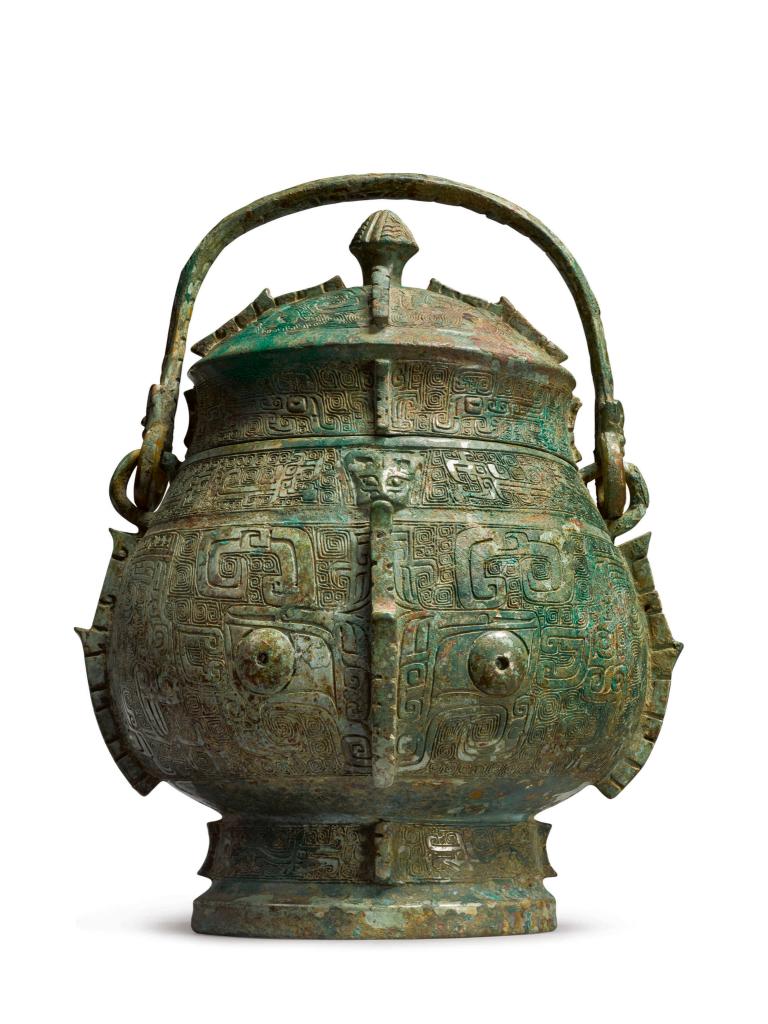
The back of the sheep can be turned over to act as a lamp panel and there is a small mouth close to the mobile knob by which the rest oil can flow into the abdomen when the lamp is unused. In the Spring and Autumn Period and the Warring States Period, bronze vessel production attained the highest level in history. The separate casting method and the lost wax method were created. Besides, new techniques such as gold and silver smearing and gold plating were adopted, making bronze vessels more diversified. In particular, the use of sharp ironware in the late Warring States Period led to the development of ornaments on bronze vessels from printed patterns to carved patterns, and lines were as thin as hairs. The gold and silver smearing technique could be used to inlay red copper, gold and silver lines or gold and silver foil on dented patterns and form various delicate and beautiful images. The pot with banquet, fishing hunting and war patterns is a representative work made using the gold and silver smearing technique in the Warring States Period. After the Warring States Period, because of the development of iron smelting techniques, the improvement of ceramic techniques and the rise of lacquer ware, bronze vessels gradually exited the stage of mainstream Chinese traditional arts and crafts. In the Qin and Han dynasties, most bronze vessels were still for practical use. There were less sacrificial vessels and more utensils of everyday use. Light utensils had with simple decorations, and skills of showing decorations while keeping plated gold shiny prevailed. The most representative Han bronze vessels were lights and censers, not only numerous in number and type, but also exquisite and having abundant ingenious functions. The most famous one is the Changxin Palace Lamp unearthed from Mancheng, Hebei: a graceful kneeling maid of honor supporting a lamp with the left hand and lifting the lampshades with the right hand. The sleeves are siphons sucking lampblack into the hollow body filled with water to reduce air pollution. The two tile-shaped lampshades on the round lamp body can be used to adjust the direction of light at will. Its ingenious design and exquisite craftsmanship manifest highly united practical use and beautiful appearance. These “oil lamps”with smoke conduits have abundant shapes and styles such as people, cows, sheep and birds. They are both lights and ornaments. Censers are represented by the bean-shaped Boshan burners. There seem to be meandering miniature mountains and vaguely visible beasts and hunters on their lids, manifesting Han people’s thoughts about immortals.
Bronze Boshan Censer with Gold-inlaid Cloud Patterns of the mid Western Han Dynasty, 26cm in height, kept in Hebei Provincial Museum. With a shape of a bean, its top is covered with ranges of mountains.Through bronze vessel production gradually declined, bronze mirrors as a unique type of bronze artworks continued to develop and reached several artistic peaks-for example, mirrors of the Warring States Period, mirrors of the Han Dynasty, mirrors of the Tang Dynasty and mirrors of the Song Dynasty were abundant in style, exquisitely made and highly decorative. The plain front side of the bronze mirror was conducive to combing hair and putting on makeup, and the back side was often decorated. Later, bronze mirrors were used to reveal and ward off evil spirits. Mirrors of the Warring States Period were mainly the Chu State’s products with exquisite decorations on the back sides. Their themes included mountains, squares and circles, four leaves, two water chestnuts, etc. Apart from casting patterning techniques included colored painting, gold and silver smearing, jade inlay, colored glaze inlay, etc. Han mirrors were exquisitely cast without any ground pattern There were strictly symmetrical clear patterns around the mirror knob such as grass leaves, stars, clouds, four hornless dragons, lattices, squares and circles, connected arcs, curling dragons, phoenixes and holy beasts. Han mirrors’ sizes were generally small, but there were super-large exceptions, e.g. round mirrors more than 45 centimeters in diameter and square mirrors 115 centimeters long. Lenses made in the mid-and late Western Han Dynasty could magically project graphics on their back sides to walls under sunlight through operation of optical and mechanical laws. Tang mirrors with diversified shapes, extensive themes and delicate decorations were made through careful smelting and casting. It is said that well-known Yangzhou mirrors were made after repeated smelting. Decorative patterns included the four-god pattern, the Chinese zodiac pattern, the propitious beast pattern, the flower and bird pattern, the figure pattern and the Eight Diagrams pattern. Compositions were free and changeful. Tang mirrors were exquisite and popular for two reasons: first, Tang mirrors were often decorated with miniature palaces and temples on their back sides; second, in the Tang Dynasty, presenting bronze mirrors as tribute or gifts was a prevailing custom. According to The Book of Tang-Records on Rites, in the peak period of the Tang Dynasty, Emperor Xuanzong’s birthday (the 5 th day of the 8 th lunar month) was the “Qianqiu Festival.” Ministers presented honey and birthday wine as tribute and gave bronze mirrors to the emperor as birthday gifts or to each other as presents Song mirrors had many shapes such as the round shape, the square shape,the”亞” shape, the sunflower shape, the water chestnut flower shape, the rectangular shape, the heart shape, the shield shape, the bell shape, the tripod cauldron shape and mirrors with handles as well as abundant themes such as flowers, grass, birds, beasts, mountains, rivers, small bridges, towers, figures, stories, the Eight Diagrams, trademark inscriptions and propitious inscriptions.
Though more and more unconventional shapes and new patterns emerged, plain mirrors without any back decoration were the mainstream. They were cast and roughly declined increasingly. Song mirrors, like other types of craftsmanship, showed a retro trend. The imperial court and ordinary people cast a number of masterly imitated utensils, among which those imitated by the imperial court during the reign of Emperor Huizong of the Song Dynasty were most famous. The shapes and decorations of a number of pseudo -classic bronze vessels and sacrificial vessels looked quite ancient and could almost pass for genuine ones. After the Yuan and Ming dynasties, bronze mirror production further declined and most bronze mirrors only had inscriptions on years of production without any decorative pattern; apart from the traditional patterns, novel ones such as the two -fish pattern, the two-dragon pattern, figures and stories such as delivery of letters by Liu Yi emerged. Most Yuan bronze mirrors had the six-petal water chestnut flower shape or the six-petal sun flower shape, but their patterns were rougher and simpler. Decorative patterns on bronze mirrors other than plain mirrors mainly included interlocking branches of peonies, immortals, figures, stories, two dragons, inscriptions about longevity, etc. In the Ming Dynasty, imitating Han mirrors and Tang mirrors, mostly Han mirrors with the six-stick pattern and Tang mirrors with propitious beast and grape patterns, was prevailing custom, but they were smaller in shape with vague patterns. The past charm was gone. After the Ming Dynasty, bronze mirrors were gradually replaced by glass mirrors. Square Mirror with Lion Grape Patterns of the Tang Dynasty, 17.1cm each side, kept in Shosoin of Japan. The high relief craft is adopted for the mirror the inner area of which is decorated with six lions distributed around the beast knob as well as grape patterns distributed among the lions and the outer area of which is decorated with birds and butterflies as well as the patterns of grape-entangled branches. The mirror’s edge is decorated with the patterns of entangled branches. Xuande burners, bronze incense burners designed and cast with imported high -grade copper and other refined materials for ornamentation and worshipping in the imperial palace in the Xuande Period of the Ming Dynasty, were the first bronze vessels cast with brass in China’s history. Attention was paid to the shapes of such vessels with few decorations. Drawing on tripod cauldrons and ancient wine vessels of the Shang and Zhou dynasties and porcelain ware of the Northern Song Dynasty and the Southern Song Dynasty, they had elegant shapes and primitive styles.
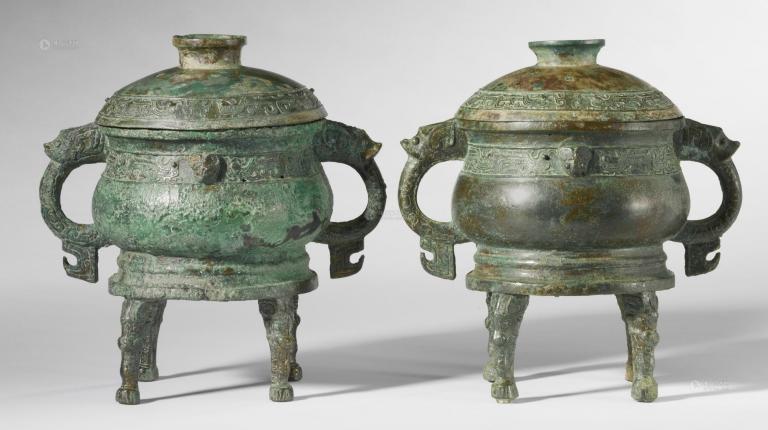
Their basic structure was a broad opening, a square or round edge, short and thin neck, a flat and extruded body, three blunted-shap-cone- feet or two split follow feet, ears in the shape of bridge, beat or”了”on the edge of the opening, and an inscription on the year of production on the outer bottom of the burner. Xuande burners made of different materials had as many as dozens of different colors and very expensive. From the Ming Dynasty, imitation became a common practice. It was hard to distinguish between real Xuande burners and good imitations. Modern Copper Hot Pot, originated in Lijiang, Yunnan, 37cm in height and 33cm in diameter. Formed by forging the red copper, it is a household daily cooker in winter. With round shape, its body is full of round dots with a decorative function. Qinghai Copper Pot of the former Republic of China period, 20cm in height, made of brass. Three lotus petal-shaped holes are engraved at the vessel mouth with the edge decorated with red copper, and the body is decorated with red copper lotus petal patterns. The overall shape is unique which is rarely seen among the folk cookers. The Bronze Pavilion of Precious Clouds built in the 20 year of the Qianlong Period of the Qing Dynasty (1755) is a magnificent and peculiar work epitomizing the greatest achievements in bronze vessel casting in the Qing Dynasty. The Pavilion of Precious Clouds with double-eave gable and hip roof is an imitation of the shape of wood-structure buildings. The whole pavilion located on a Sumeru throne of carved white marble has greenish grey and cold bronze colors. There are bronze-cast wood-grained structures such as pillars, girders, rafters, tiles and ridges outside,and bronze-cast Buddhist statues, bronze-cast altars, etc. made with smelting molds using the lost wax method inside. Artisans cast the bronze pavilion’s components of different sizes first before connecting them into a complete bronze pavilion. The 6-meter-tall Tsongkhapa statue in the Lama Temple in Beijing was cast from 1924 to 1926. It was made through carefully hammering thin sheet copper by hand, and showed the consummate skills and techniques of copper casting in Beijing. The statue is also very rare in the world’s history of Buddhist statue production. After 1949, production of traditional utensils of everyday use and Buddhist statues resumed, and exquisite pseudo-classic- bronze vessels were made. Besides, new themes and new forms of bronze architectural decorations also emerged. There is a huge gold-plated army emblem 6 meters in diameter and 8 meters tall on top of the Chinese Military Museum Building. It took one year for 50 artisans to hammer and weld it. The national emblems on the Great Hall of the People and the Tian’anmen Tower meters indiameter were made through hammering thick sheet copper to create planar relief with great care.
The inscription on the Monument to the People’s Heroes was also made with sheet copper. It was plated with gold and inlaid into the monument, symbolizing eternity. With the development of modern smelting and casting techniques, bronze alloy products became more and more delicate. Unique casting techniques, exquisite carving methods and close association with history, metallurgy, language and plastic arts reinvigorated bronze art through collection, appreciation and everyday use in modern China.
